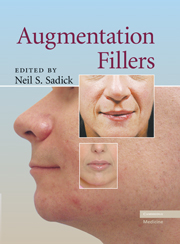Book contents
- Frontmatter
- Contents
- LIST OF CONTRIBUTORS
- Ch. 1 Application of Fillers
- Ch. 2 Approach to Choosing the Ideal Filler
- Ch. 3 Patient Selection, Counseling, and Informed Consent
- Ch. 4 Hyaluronic Acid Skin Derivatives
- Ch. 5 Collagen Products
- Ch. 6 Radiesse
- Ch. 7 ArteFill
- Ch. 8 Augmentation Fillers in Cosmetic Dermatology: Silicone
- Ch. 9 Advanta Expanded Polytetrafluoroethylene Implants
- Ch. 10 Sculptra
- Ch. 11 Lipo Transfer
- Ch. 12 BioAlcamid®
- Ch. 13 Combination of Approaches in Augmentation Fillers in Cosmetic Dermatology
- Ch. 14 Filling Complications
- Ch. 15 Postprocedure Management and Patient Instructions
- Ch. 16 Conclusion: Future Trends in Fillers
- INDEX
- References
Ch. 11 - Lipo Transfer
Published online by Cambridge University Press: 26 February 2010
- Frontmatter
- Contents
- LIST OF CONTRIBUTORS
- Ch. 1 Application of Fillers
- Ch. 2 Approach to Choosing the Ideal Filler
- Ch. 3 Patient Selection, Counseling, and Informed Consent
- Ch. 4 Hyaluronic Acid Skin Derivatives
- Ch. 5 Collagen Products
- Ch. 6 Radiesse
- Ch. 7 ArteFill
- Ch. 8 Augmentation Fillers in Cosmetic Dermatology: Silicone
- Ch. 9 Advanta Expanded Polytetrafluoroethylene Implants
- Ch. 10 Sculptra
- Ch. 11 Lipo Transfer
- Ch. 12 BioAlcamid®
- Ch. 13 Combination of Approaches in Augmentation Fillers in Cosmetic Dermatology
- Ch. 14 Filling Complications
- Ch. 15 Postprocedure Management and Patient Instructions
- Ch. 16 Conclusion: Future Trends in Fillers
- INDEX
- References
Summary
For volumizing the aging face, few fillers display the versatility, endurance, and safety profile as autologous fat. Fat is the perfect choice for those patients wishing to add contour and projection to an otherwise flat visage. Understanding the concepts of facial volumetric aging is paramount to success with any filler but especially one as long lasting as autologous fat. In youth, facial contours are “balanced” with fat resplendent and diffuse. As the face ages, the fat becomes “unbalanced” and dependent on its overall body content. Recent anatomical research suggests that the face is made up of discrete separate fat compartments and that these compartments age individually. This is perfectly illustrated by comparing the atrophic aging seen all over in a patient of ascetic body type with the combination of hypertrophic and atrophic aging seen in a more corpulent individual. It appears that increasing body fat leads to deposits or hypertrophy of fat in certain fat compartments, while others remain atrophic (Figure 11.1A,B). It is unknown as to why the face ages compartmentally, but luckily, the transfer of autologous fat back into the atrophic areas can restore a sense of balance and youth to the face.
PLANNING
During the initial consult, it is helpful for patients to bring in a photograph of what they looked like ten years ago. It is important to ask the weight of the patient currently as compared with the time of the old photograph.
- Type
- Chapter
- Information
- Augmentation Fillers , pp. 103 - 112Publisher: Cambridge University PressPrint publication year: 2010



